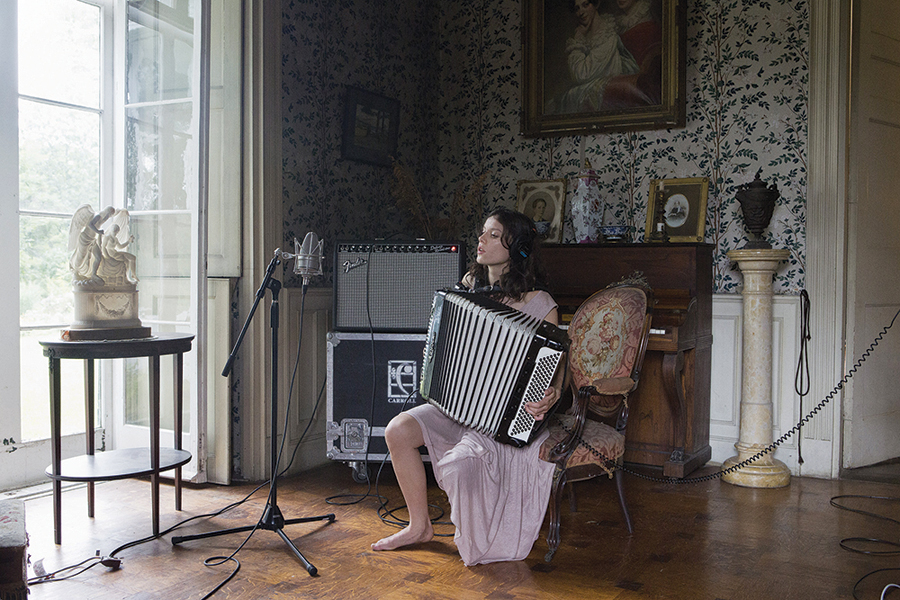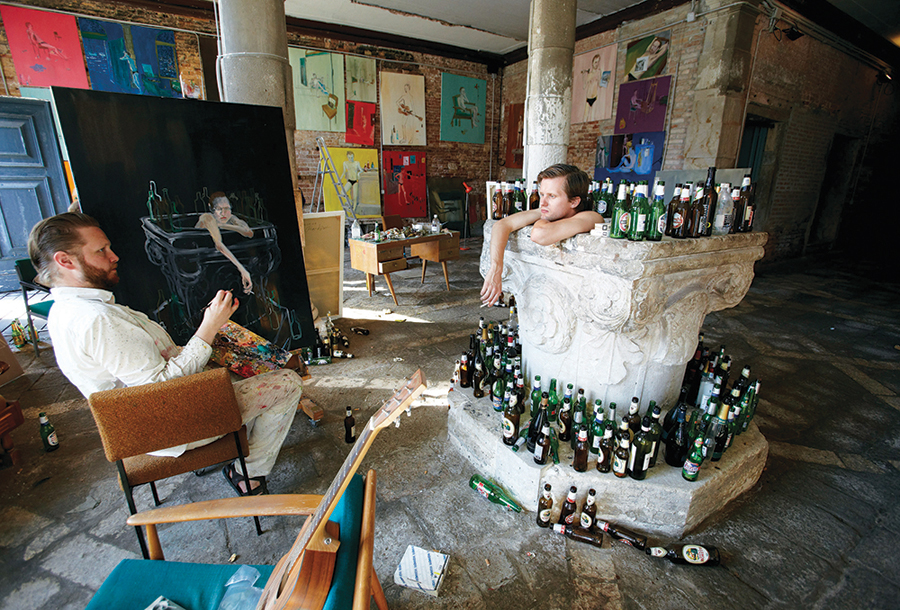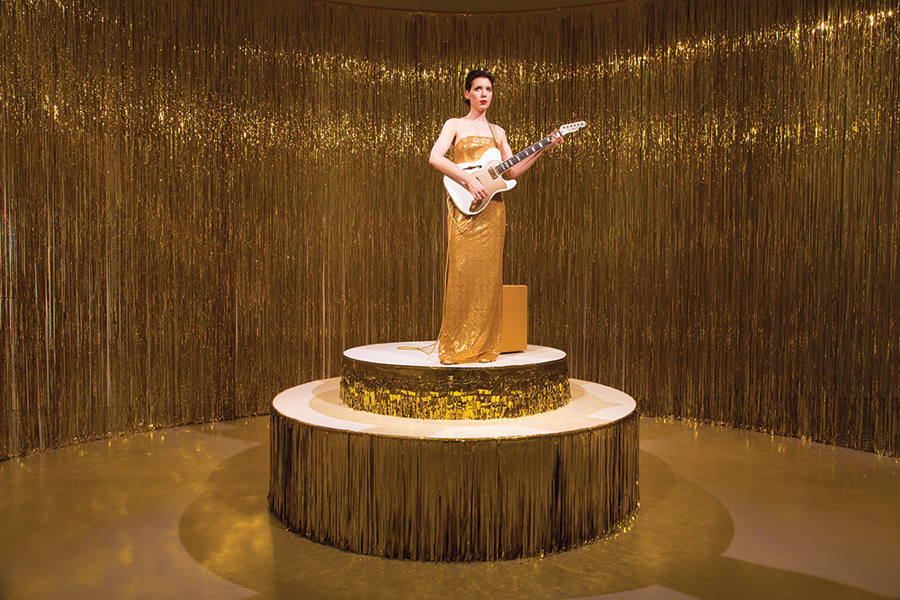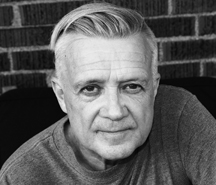« Feature
Ragnar Kjartansson. A Rake’s Progress Hits the Sublime and the Not So Much
Billed as “an unprecedented solo exhibition-the first U.S. survey of this internationally acclaimed artist,” by the Hirshhorn Museum and Sculpture Garden, this timely and ambitious show gave the opportunity to review a feast of work by an artist whose reputation has grown exponentially in recent years. The survey covers the breadth of Ragnar Kjartansson’s oeuvre, including live performances, documentations of performances, video installations, paintings, sculptures and accompanying sketchbooks.
At the entrance to the show, we are welcomed by a large neon sign proclaiming “Scandinavian Pain.” Illuminated with a cheery, ironic pink, it signals the importance of the artist’s Icelandic roots, just as it heralds his dry humor and Nordic melancholia.
Packed with a young crowd that looked as if they longed to be participants in one of his performances, the galleries were nevertheless quiet with the hushed, reverential air of a Rembrandt retrospective; plenty of knowing smiles, but not the stifled laughter and amusement I expected.
The survey opens with one of the artist’s earliest and strongest video pieces, Death and the Children (2002). Shot in a grainy, gothic, black and white, the artist is dressed as “death” in dark 19th-century clothes to ambush–with the teacher’s permission–a troupe of enthusiastic elementary-aged school children on a field trip. He intercepts them in a cemetery and, in a booming, scary voice, the Grim Reaper confronts the young children, addressing them theatrically on the subject of death, then leading them bobbing through the cemetery, bubbling with excitement and trepidation. Gradually, the children gain in confidence and skepticism at this amateur-looking Grim Reaper and his alarming words –”Your scythe is fake!” says one, “You’re just an elf with a stick!” says another. Before they know it, he disappears, chastened, into a crypt to the netherworld.
Kjartansson has introduced the children to an adult interpretation of their world, treading the fine line between fear and fun that children relish. It’s a beautifully layered piece, simultaneously about childhood innocence yet resilience, presented with purity and tenderness.
Another early piece has a similar directness and cutting-edge flavor. In Me and My Mother (2000), and repeated in 2005, 2010 and 2015, the artist’s mother stands rather formally next to Kjartansson and periodically turns to spit on him venomously and unapologetically. In the first rendition, there is a tension of intent between them as they break the bond of mother and son. So simple and so surprisingly shocking, the ritual has been repeated every five years since, with lessening power.
In 2007, his career already established, the artist gave us a contrastingly glossy and brilliant pastiche of glitzy period Americana in God. In this single video projection, a tuxedo-clad Kjartansson (an admitted Sinatra nut), croons 1950s-style along with an 11-piece band. The artist sings just one subversive lyric, which undoes the upbeat and sophisticated cabaret setting: “Sorrow conquers happiness.” A mournful, stretched-out rendition, it conjures up not so much the Rat Pack on Jack Daniels as Rufus Wainwright in Scandinavian pain. The publicity photo from this performance captures the mood so perfectly that the single image alone convinces in the manner of a Cindy Sherman film still. Having seen that image, there was a real sense of disappointment that this wasn’t a live performance.
God is closely related to Woman in E (2016), the only live performance in the survey and coming a full nine years later. Again, the presentation is cabaret-style, with the female performer dressed in a gold-sequined evening dress, partially hidden within a circle of gold tinsel curtains, which we must visually penetrate to see her. She is seated and very slowly, self-consciously strums a single E chord on an electric guitar.
Kjartansson has explained that this performance is a commentary on the objectification of women–she is literally on a pedestal. As such, it doesn’t seem to be making a clear point, as the performer appears to be acting out the specific will of her (male) director, with no autonomous power evident.

Ragnar Kjartansson, The Visitors, 2012, nine-channel video projection, 64 minutes. Photo: Elísabet Davids. Courtesy of the artist, Luhring Augustine, New York, and i8 Gallery, Reykjavik.
The two most powerful and well-attended pieces in the survey are both multi-channel video installations. The Visitors (2012), is a nine-projection installation, and World Light-The Life and Death of an Artist (2015), a four-channel video that most obviously references Kjartansson’s theatrical family background.
The Visitors is set at Rokeby Hall, a grand, colonial-style mansion in upstate New York. In its beautifully dilapidated interior, a group of musicians play their instruments in separate locations. We are surrounded by the projections, spread around the gallery set at angles to one another, and playing concurrently. Earpieces give away that the initially casual bohemian jam–Kjartansson plays his guitar naked in the bath-is, in fact, a carefully coordinated, complex and evocative musical arrangement. The instrumental builds and joins with vocals until the lilting refrain of “Once again I fall into my feminine ways” coalesces and dominates. The performers and others in the house gather together, singing and accompanying each other as the loose-limbed mantra takes a hold of the entire party. Entranced, they slowly spill out of the house and off into the pastoral landscape, to the fading strains of the refrain.

Ragnar Kjartansson, The Visitors, 2012, nine-channel video projection, 64 minutes. Photo: Elísabet Davids. Courtesy of the artist, Luhring Augustine, New York, and i8 Gallery, Reykjavik.
If a sense of longing and sadness presides–the piece was apparently a consequence of the artist’s split from his then wife–the collaborative nature and inclusivity of the piece transforms it into an uplifting spiritual, which had the tangible effect on the spellbound “visitors” to the gallery of appropriating them into the performance. They remained reluctant to leave at the conclusion, as if held by a symbiotic embrace between the performers and audience.
Based on the epic novel by Icelandic Nobel Prize-winning novelist Halldór Laxness, World Light is a four-channel presentation with particularly large-scale projections. Although a more straightforward installation than The Visitors, the content is an altogether more visually challenging and intense collage, with a dense narrative that pays homage to a text Kjartansson has described as his “bible.”

Ragnar Kjartansson, The Visitors, 2012, nine-channel video projection, 64 minutes. Photo: Elísabet Davids. Courtesy of the artist, Luhring Augustine, New York, and i8 Gallery, Reykjavik.
Ostensibly staged with the use of actors rather than participants, as well as scenic props, staged special effects and influences from both Nordic film and the artist’s love of opera, the installation is the result of a one-month filmed performance. With 80 scenes in all, it was produced at the Thyssen-Bornemisza Art Contemporary in Vienna. In this epic undertaking, the artist finally fully engages with the seminal influence of his family’s theatrical background; one provocative tableau after another filled with the raw emotion and complex interpersonal relationships that were the life of folk poet Ólafur Kárason.
It was difficult to give this 20-plus-hour epic of Kjartansson’s the attention it deserved, with so many other pieces in the show being measured in hours, not minutes. World Light suggests that the survey might thus have benefitted from fewer selections.
This touches on the much-discussed emphasis on repetition and endurance in Kjartansson’s work, which while integral to some pieces, is not so in others, as his own words suggest. When describing Woman in E, for example, the artist says, “For the audience, it’s a very free invitation to look at it for as long as you want. You can go and sit there for hours or take a glance at it for one minute–sort of gives you the same kick.”

Ragnar Kjartansson, The End – Venezia, 2009, (June 2009), six month performance during the 2009 Venice Biennale during which 144 paintings were made.
This principle is again demonstrated in the Hirshhorn theater, where a video features The National, Kjartansson’s favorite band performing A Lot of Sorrow, in a six-hour nonstop repetition of the same song. Here, just like Warhol’s Empire, (eight hours plus), it gives these pieces an important context to know what the duration is, even if you do just “glance at it.”
Kjartansson has represented Iceland at two Venice Biennales, and at the 53rd he explores the eternal “block” of the painter. Kjartansson plays the role to the hilt, passing up the standard solution of painting the view through the window–those Venetian views are too hot to handle—and instead has his friend Páll Haukur Björnsson pose for him as the stereotypical debauched artist, replete in Speedo swim shorts, while both of them drink and smoke themselves into Hogarthian excess–or at least act it out.
Painted largely wet-on-wet, every variant of languid, louche and world-weary pose is explored, portrayed on a rainbow of brightly hued grounds, carefully designed to animate the salon-style hanging. All 144 paintings are exhibited. Thus, we are grateful to Kjartansson for exorcising the ghost of a “last resort” that every artist who has ever attended a residency must have dreaded while also delivering a genuinely amusing installation of “amateur” paintings in mix-and- match sizes and colors. The installation is one of the highlights of the show.
Not so the piece the artist created for the 55th Biennale, which is a much less successful partner, far from its original context of Venice. S.S. Hangover (2013-2014), depicts a fishing sailboat with a cargo of musicians playing their instruments, setting out from a dock in the bay for a two-hour journey to another dock. It is shown in two projections joined together as a mirror image. One musician is dropped ashore occasionally to play isolated from the others, the sense of separation creating a metaphorical mirrored effect, if not an aural one.

Ragnar Kjartansson, The End – Venezia, 2009, (June 2009), six month performance during the 2009 Venice Biennale during which 144 paintings were made.
Called by one critic at the time “one of the most haunting spectacles in the history of the biennale,” it appears to be a faintly pompous and redundant exercise here, without the glorious location of Venice permeating our senses.
The real weak link in the show, however, is Nur wer die Sehnsucht kennt (2015), which is comprised of a series of painted stage “flats” of snow-topped rocks, or possibly mountains, about waist high, arranged facing the direction in which visitors move through the show. As you walk past them, you see their unfinished plywood backs that wouldn’t normally be visible to a theater audience. I thought they were items left over from a live talk or performance, but apparently not.
The label for the show describes the piece thus: “On approach, one is confronted with a picturesque landscape of snowy rocks, but as the scenery is navigated, the flimsy plywood of the set pieces is revealed from behind, suggesting the disappointment that inevitably lies on the other side of romantic desire.”
Coming after the ambition and intricacy of the video installations, this concept looks as flimsy as the plywood. Even Kjartansson’s small sketchbooks nearby are stuffed with enticing projects and whimsical humor and prove, despite the artist’s protestations, that he can indeed draw.
There were times during this show that I found myself wanting to whack Kjartansson round the head with the memory of Chris Burden or Martin Kippenberger or agree that he is “just an elf with a stick.” But again and again I am, almost reluctantly, drawn back to Kjartansson’s unique marriage of lush image and music, his lyricism and slovenly beauty, summoned up by his array of talented participants and performers who bring to life the deeply indulgent and seductive tableaux that tap into our emotional core. Pieces that are new, that are fresh.
As Kjartansson says in the catalog accompanying the show, “Since life is so much abyss and pointless and useless, I decided to look at it as paradise.” Bravo to that, though this fascinating survey both supports the artist’s burgeoning rise to prominence with sublime moments and questions that status with uneven work and inherent contradictions.
Perhaps I’ll defer to Kjartansson’s mother and her pithy quote: “Why spoil a good story with the truth?”
Tim Hadfield, a British artist, educator and curator, is currently a professor of media arts at Robert Morris University in Pittsburgh. He has exhibited widely in the United States, Europe and Asia. As a curator, he has presented exhibitions across the U.S. and internationally. In 2003, he was elected a Fellow of the Royal Society of Arts and in 2010 co-founded the Sewickley Arts Initiative.









































Leave a Reply
You must be logged in to post a comment.